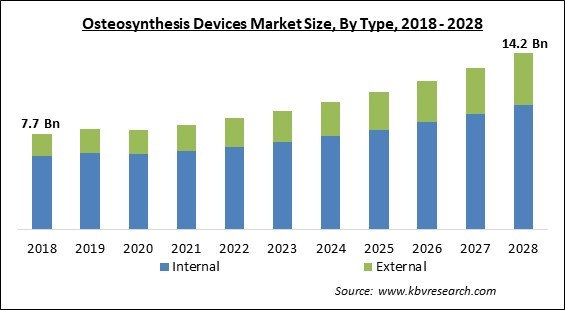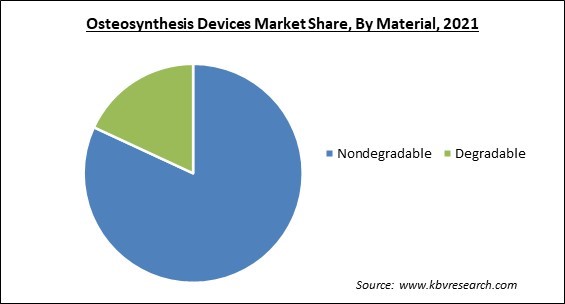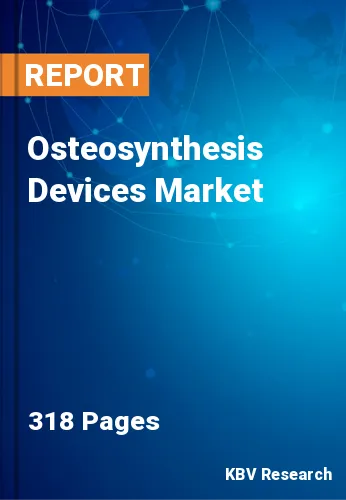The Global Osteosynthesis Devices Market size is expected to reach $14.2 billion by 2028, rising at a market growth of 8.0% CAGR during the forecast period.
One of the most often used surgical methods in orthopedics, including both elective orthopedics and traumatology, is osteosynthesis. It entails the joining of two or more bone fragments after they have first achieved correct alignment. In order to keep the union mechanically stable until the biological process of fracture healing has rebuilt the bone segment as a single unit, screws, nails, plates, and other mechanical devices are used.

Therefore, materials used in osteosynthesis must have biological properties that can keep them in apposition with the bone for a period of time, during which they must not hinder or interfere with the bone process of healing and, if possible, must support and encourage it. They must also have mechanical properties sufficient to take the load on the injured bone segment.
Positive demographic trends, continuous product innovation, an increase in physician skill, enhanced value-based payment methods, and site-of-service flexibility will all continue to favorably impact the market. For instance, the financial framework for osteosynthesis device treatment has undergone significant recent revisions, notably with regard to site-of-service pricing.
The need for treatments utilizing osteosynthesis devices will rise as a result of injuries incurred by drivers and passengers in car accidents. As more individuals use motorbikes as their major form of transportation due to their affordability, injuries from motorcycle crashes will also have an impact on the market.
The COVID-19 pandemic has done a great deal of damage to the market for osteosynthesis devices. The spread of the COVID-19 virus caused a significant fall in the sales of surgical equipment during the early stages of the pandemic. In order to maximize the amount of hospital space available for COVID-19 patients during the pandemic, all elective surgeries were also delayed or canceled. Due to the new coronavirus's extensive circulation and the lockdown measures that followed it, many patients have been disallowed access to bariatric surgery.
Physicians are increasingly adopting minimally invasive spine procedures to treat vertebral compression fractures and other spinal-related problems. It is because these procedures help in stabilizing the vertebral bones & spinal joints and/or release pressure being applied to the spinal nerves, which generally lead to the conditions like bone spurs, spinal instability, scoliosis, herniated discs, or spinal tumors. Thereby, these factors would drive the demand for the Osteosynthesis Devices Market.
The large growth in the number of elderly people and osteoarthritis patients is leading to an increase in surgical procedures performed globally. Chronic illnesses that necessitate several operations are more likely to occur in adults 60 years of age and older. In low-, middle-, and high-income nations, non-communicable illnesses are anticipated to represent more than 87% of cases by 2030, which would increase the demand for surgery. The prevalence of such ailments is driving the market for osteosynthesis devices.
In orthopedics and traumatology, infection is still a significant postoperative consequence. Infection prevention may depend heavily on the implant's design, material, and implantation method. These infections are frequently brought on by bacteria that produce biofilms. The use of surgical debridement and antibiotics is required by therapeutic algorithms. The existence of bacterial biofilms, which are frequently linked to slow-growing microorganisms, low bacterial loads, prior antibiotic treatments, and potential intra-operative contamination, make the microbiological detection of implant-related illnesses difficult.
Based on type, the osteosynthesis devices market is divided into Internal and External segments. Internal fixation equipment generated the largest market share in 2021 due to being the most frequently used surgical procedure worldwide. Metal plates, nails, and screws are the most often used internal fixation methods for treating fractures. These devices assist in retaining the fractured bone together by stabilizing and supporting it.

Based on material, the Osteosynthesis Devices Market is divided into Degradable and Non-degradable. The degradable segment showcased the significant revenue share in the market in 2021. Devices made of biodegradable polymers are effective for osteosynthesis in instances involving minor to no load bearing. To increase their utility, biodegradable devices must improve their mechanical characteristics and degrading behaviour.
Based on the fracture type, the market is categorized into the skull, facial bones, sternum or one or more ribs, or both, clavicle, scapula, or humerus, radius or ulna, or both, hand, wrist, or any other distal portion of the hand, vertebral column, pelvis, hip, femur—other than the femoral neck—patella, tibia, fibula, or ankle, and any foot bones other than the ankle. Clavicle, Scapula, or Humerus accounted for the considerable revenue share in the market in 2021. In the fifth week of foetal development, the clavicle becomes the first bone in the human body to undergo intramembranous ossification directly from mesenchyme. The clavicle has a medial and lateral epiphysis, like other long bones, but no clearly defined medullary cavity.
| Report Attribute | Details |
|---|---|
| Market size value in 2021 | USD 8.4 Billion |
| Market size forecast in 2028 | USD 14.2 Billion |
| Base Year | 2021 |
| Historical Period | 2018 to 2020 |
| Forecast Period | 2022 to 2028 |
| Revenue Growth Rate | CAGR of 8% from 2022 to 2028 |
| Number of Pages | 318 |
| Number of Tables | 570 |
| Report coverage | Market Trends, Revenue Estimation and Forecast, Segmentation Analysis, Regional and Country Breakdown, Companies Strategic Developments, Company Profiling |
| Segments covered | Type, Material, Fracture Type, Region |
| Country scope | US, Canada, Mexico, Germany, UK, France, Russia, Spain, Italy, China, Japan, India, South Korea, Singapore, Malaysia, Brazil, Argentina, UAE, Saudi Arabia, South Africa, Nigeria |
| Growth Drivers |
|
| Restraints |
|
Based on geography, the Osteosynthesis Devices Market is divided into North America, Europe, Asia Pacific, and LAMEA. In 2021, North America led the market and generated the most significant revenue share due to considerable government initiatives, the introduction of new products, and significant R&D investments. With the highest revenue share in North America, the United States is the most lucrative and most significant market for osteosynthesis equipment due to rising healthcare costs and the concentration of the country's primary orthopedic device industry.
Free Valuable Insights: Global Osteosynthesis Devices Market size to reach USD 14.2 Billion by 2028
The market research report covers the analysis of key stake holders of the market. Key companies profiled in the report include DePuy Synthes, Inc. (J & J Company), Stryker Corporation, Zimmer Biomet Holdings, Inc., Smith & Nephew PLC, Medtronic PLC, Olympus Corporation, Globus Medical, Inc., Arthrex, Inc., Lepu Medical Technology Co., Ltd, and Life Spine, Inc.
By Type
By Material
By Fracture Type
By Geography
The global Osteosynthesis Devices Market size is expected to reach $14.2 billion by 2028.
The Shift Toward Minimally Invasive Spine Procedures are driving the market in coming years, however, Osteosynthesis complications such as implant-associated infections (IAI) continue to be difficult restraints the growth of the market.
DePuy Synthes, Inc. (J & J Company), Stryker Corporation, Zimmer Biomet Holdings, Inc., Smith & Nephew PLC, Medtronic PLC, Olympus Corporation, Globus Medical, Inc., Arthrex, Inc., Lepu Medical Technology Co., Ltd, and Life Spine, Inc.
The expected CAGR of the Osteosynthesis Devices Market is 8.0% from 2022 to 2028.
The Nondegradable segment acquired maximum revenue share in the Global Osteosynthesis Devices Market by Material in 2021 thereby, achieving a market value of $11.1 billion by 2028.
The North America market dominated the Global Osteosynthesis Devices Market by Region in 2021, and would continue to be a dominant market till 2028; thereby, achieving a market value of $5.9 billion by 2028.
Our team of dedicated experts can provide you with attractive expansion opportunities for your business.

